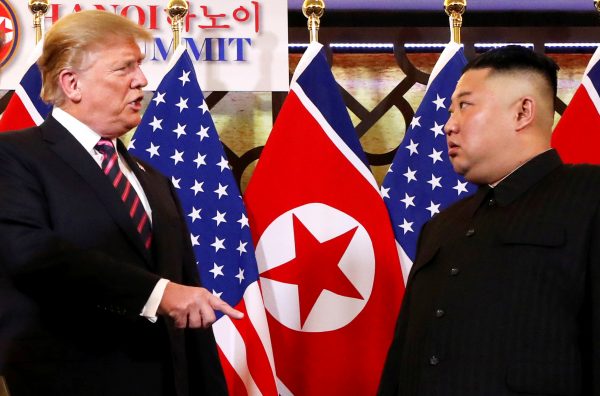What were the structural faults of this ‘no-deal’ for denuclearisation and what must be done in the future to advance denuclearisation’s cause?
In the negotiations, Trump proposed a ‘big-for-big deal’, trading complete denuclearisation for a lifting of a swathe of economic sanctions. This was reportedly rejected by North Korea.
It would be reasonable to believe that North Korea did not accept this ‘big-for-big deal’ because it intends, for the time being, to hang on to its capabilities. Reinforcing this, an International Atomic Energy Agency (IAEA) report noted that, despite the shutdown at Nyongbyon, there were signs that the light-water reactor remains operational.
According to recent reports, the United States pointed out a further facility concealed underground in northwestern Nyongbyon and requested its inclusion among negotiations. North Korea apparently had not anticipated this mention. Trump demanding its inclusion suggests Kim tried to preserve a concealed degree of manufacturing capability. North Korea has expressed willingness to denuclearise. But the absence of any clear-cut mention of nuclear warheads, stockpiled nuclear materials, and nuclear material production facilities other than Nyongbyon indicate that North Korea is not aiming for ‘complete denuclearisation’. Rather, they are aiming for a ‘symbolic’ partial denuclearisation by closing already-known facilities.
These ‘symbolic’ tactics mean to demonstrate that North Korea has no hostile intent through abolishing some capability, without revealing their program’s full extent. This endeavours to lessen negotiating partners’ perceptions of North Korea as a threat, even as they cling on to their nuclear capability, at least for now.
This aims to establish a relationship similar to that achieved between the United States and the USSR/Russia during and after the Cold War. It also presumes nuclear weapons possession by both the United States and North Korea, guaranteeing North Korea’s national and regime security. Calling for US-led verification rather than IAEA-led is another indication that North Korea wants to follow a path resembling confidence-building between permanently nuclear-armed states.
This wide gulf in thinking between the United States and North Korea applied similarly to the lifting of economic sanctions. North Korea requested a lifting of sanctions connected with five UN Security Council resolutions. This would constitute only a partial and not a full lifting of sanctions, but lifting them, including one on coal and refined petroleum product imports, are extremely important to maintain the North Korean economy. Lifting them would open the way for Chinese and Russian companies — entities not subject to US unilateral sanctions — to officially resume trading with North Korea.
From the US standpoint, such a move would mean letting go of the ‘stick’ of sanctions and, with the future objective being not just a halt of operations at Nyongbyon but complete denuclearisation, this would be too disproportionate an exchange for just the closure of Nyongbyon.
It is clear that the two sides’ differing expectations and the results they were seeking, with respect to the North Korean denuclearisation measures to be carried out and the degree of US sanctions lifting, made an accord at the recent meeting extremely improbable.
What is needed to advance future talks?
First, the two parties need to agree on the definition of ‘denuclearisation’. The collapse of the latest has taught North Korea that establishing itself as a de facto nuclear-armed state through symbolic denuclearisation poses serious challenges. Whether ‘complete denuclearisation’ is even acceptable by North Korea is very much in question. And a one-shot ‘big-for-big deal’, no matter how desirable, cannot be seen as a realistic strategy in the face of North Korea’s wariness over security risks posed by a drastic ‘complete denuclearisation’. That leaves little choice but to adopt a staged (step-by-step) approach of one form or another.
Second, the deal needs to be politically sustainable. The failures of the 2015 Iran deal and the 1994 US–North Korea Agreed Framework has stressed that any new deal needs to endure a US administration change, now the greatest risk to US international pledges. North Korea has little incentive to conclude a deal that might be broken after a US change of government. Kim himself travelling to Vietnam, only to return home empty-handed, could well have made him wary about the next meeting with the United States.
Third, a balance must be found between progress in denuclearisation and incentives granted to North Korea. For North Korea, there is no gain from denuclearising without some payback. Denuclearisation only heightens their vulnerability, so some form of security compensation is needed, as are tangible economic benefits.
Both excessive and insufficient compensation would hinder the process, so an incentive scheme must be formulated. North Korea must understand the US determination to achieve ‘complete denuclearisation’. And they need to receive sufficient economic compensation and security guarantees to encourage progress. This means no excessive lump-sum compensations that would give North Korea little need to proceed any further after a first step. This is no simple task.
Since North Korea has much more to lose than the United States from negotiation failure, a more challenging process awaits them. The inherent difficulties in finding a suitable equilibrium point for any deal mean that the United States and North Korea must make more thoughtful preparations, undertake preparatory negotiations, and move ahead by stages.
Dr Nobumasa Akiyama is Dean of the Graduate School of International and Public Policy and Professor of the Graduate School of Law at Hitotsubashi University, Tokyo. He is also an adjunct Research Fellow of the Japan Institute of International Affairs.
This article is abridged from a version that appears here at the Japan Institute of International Affairs.


Those living in the USA have seen little evidence in the Trump administration of the three qualities described at the end of this analysis. There is no reason to think he will do these things, especially when he will be increasingly focused on winning the 2020 election.